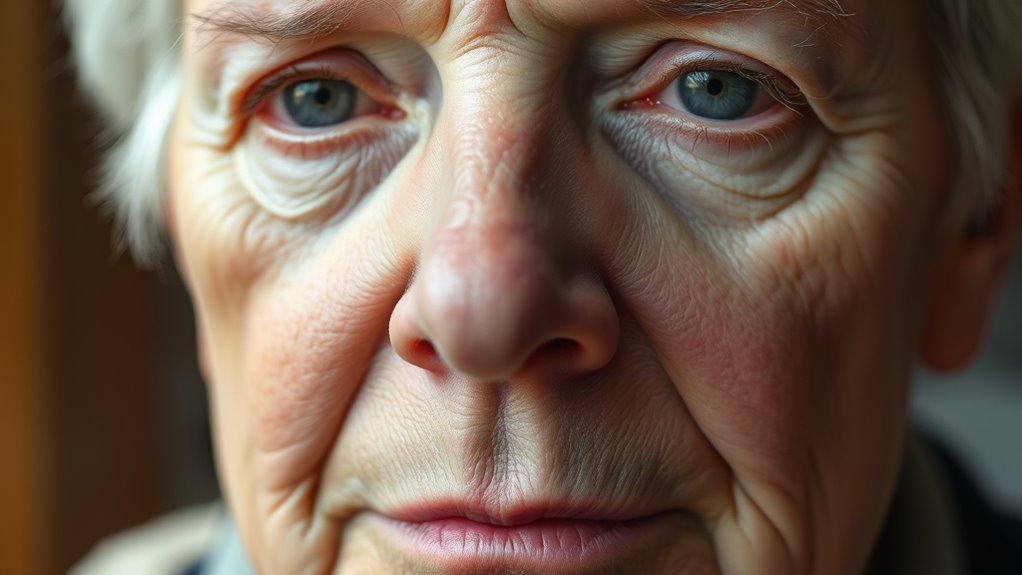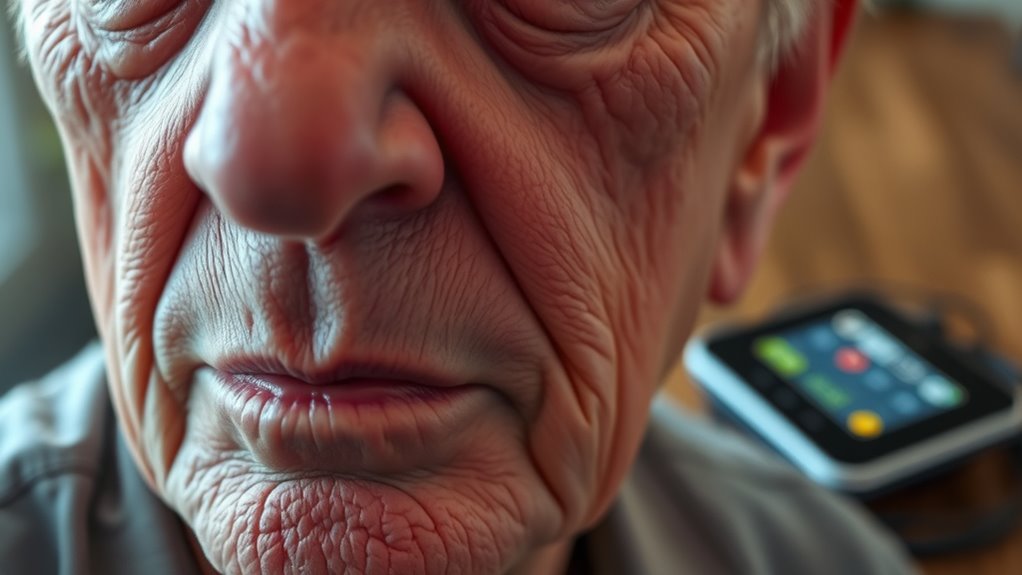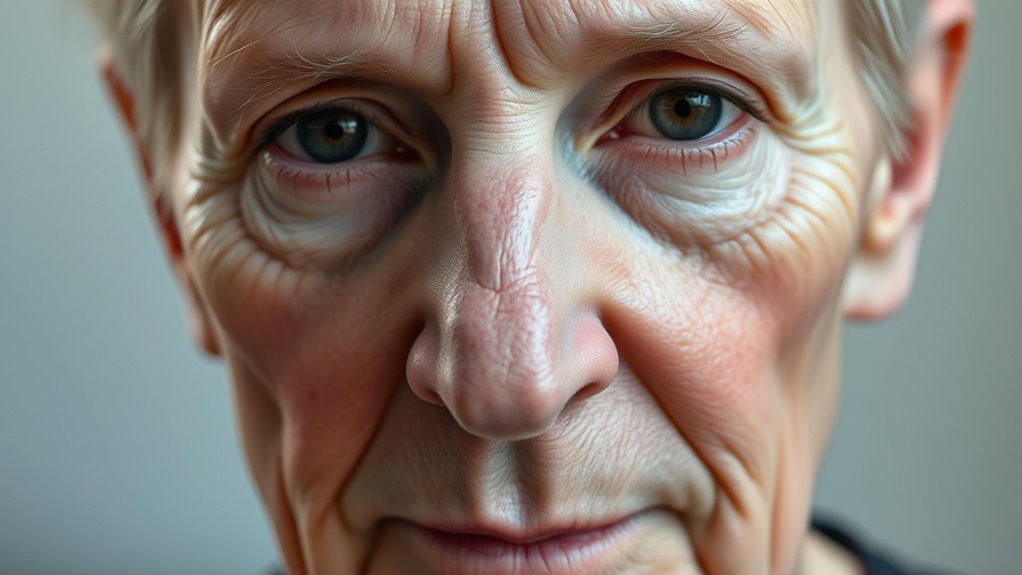If you have Parkinson’s facial masking, you might notice your face looks emotionless or less responsive, which can make it hard for others to read your feelings. However, communication isn’t just about facial expressions; pay attention to your tone of voice, body language, and eye contact. Using clear speech, gestures, or visual aids can help others understand you better. Exploring strategies and tools can strengthen your connection—discover more ways to communicate beyond your face.
Key Takeaways
- Recognize that facial masking in Parkinson’s affects muscle movements, not emotions, aiding in adapting communication strategies.
- Use eye contact, body language, and tone of voice as alternative cues to interpret feelings beyond facial expressions.
- Incorporate deliberate gestures, clear speech, and visual aids to enhance verbal and nonverbal communication.
- Utilize technology like speech-generating devices, captioning apps, and facial expression monitors to improve understanding.
- Practice patience and active listening, focusing on emotional cues beyond facial expressions to foster connection.
Understanding Facial Masking in Parkinson’s Disease

Facial masking is a common feature of Parkinson’s disease that affects your ability to express emotions through facial movements. You might notice your face appears less responsive, with a reduced ability to smile, frown, or show surprise. This happens because Parkinson’s impacts the muscles involved in facial expression, causing them to become stiff or slow. As a result, your face may seem blank or emotionless, even when you’re feeling strongly inside. This change isn’t a sign of indifference but a symptom of the neurological effects of the disease. Understanding this helps you realize that your facial expressions might not match your feelings, making it harder for others to interpret your emotions. Recognizing facial masking is the first step toward adapting your communication strategies. Enhancing communication through alternative methods can help convey your emotions more effectively despite facial limitations. Incorporating virtual communication tools can further improve how you connect with others when facial expressions are limited, and being aware of color accuracy in visual cues can also aid in better interpreting social signals.
How Facial Expressions Influence Communication

Since facial expressions are a primary way we convey emotions, they play a crucial role in communication. Your facial expressions provide cues about how you feel, helping others understand your mood and intentions. When your face reflects your emotions, it creates a connection that words alone might not achieve. For example, a smile can signal friendliness, while a frown might indicate concern or disagreement. These nonverbal signals guide interactions, build trust, and foster empathy. Without expressive cues, conversations can become confusing or misinterpreted. Your face acts as an emotional barometer, giving others insight into your true feelings. Facial expressions serve as a vital component of effective communication, especially when verbal cues are limited or ambiguous.
Recognizing Nonverbal Cues When Facial Expressions Are Limited

When facial expressions are limited, you need to pay close attention to other cues like eye contact and body language. Maintaining steady eye contact can reveal emotions and engagement that words can’t express. Watching how someone holds their posture or gestures helps you understand their feelings even when their face stays still. For example, subtle cues like microexpressions or mannerisms can also provide insight into their mood and intentions. Additionally, being aware of nonverbal communication techniques can enhance your ability to interpret emotions accurately in these situations.
Enhancing Eye Contact
Even when facial expressions are limited due to Parkinson’s facial masking, you can still effectively communicate through eye contact. Maintaining steady, gentle eye contact shows your engagement and helps others interpret your feelings. Focus on keeping your gaze natural and relaxed, avoiding darting or staring too intensely. Use your eyes to emphasize key points during conversations, letting your gaze convey interest and understanding. Blink regularly to keep your eyes comfortable and avoid appearing distracted or distant. When speaking or listening, pause occasionally to hold eye contact, creating a connection without feeling intimidating. Remember, your eyes can reveal warmth, curiosity, and attentiveness, making your interactions more meaningful despite limited facial expression. Enhancing eye contact is a powerful way to bridge communication gaps caused by facial masking.
Observing Body Language
Facial masking in Parkinson’s can make it challenging to read emotions, but body language often reveals what words cannot. Paying close attention to gestures, posture, and movements helps you understand feelings that facial expressions may hide. For example, a person’s leaning forward can show engagement, while slumped shoulders might indicate fatigue or disinterest. Hand gestures or fidgeting can also convey nervousness or excitement. Observing these cues requires patience and sensitivity, as body language might be subtle. By tuning into these signals, you can better interpret emotions and foster stronger communication, even when facial expressions are limited.
- Notice posture changes that indicate mood shifts
- Observe hand and arm movements for emotional cues
- Pay attention to eye contact and gaze direction
Emotional Impact of Reduced Facial Movements

Reduced facial movements in Parkinson’s disease can substantially affect your emotional expression, making it harder for others to read how you feel. When your face doesn’t show the usual signals—like smiles, frowns, or raised eyebrows—people might misinterpret your mood or intentions. This can lead to misunderstandings, causing friends and family to think you’re uninterested, upset, or distant, even if that’s not how you feel inside. You might also feel isolated because your emotions aren’t communicated clearly, which can affect your relationships and self-esteem. Over time, the emotional disconnect can deepen, making it harder to connect authentically with others. Recognizing this impact is vital to finding ways to express your feelings more effectively and maintain meaningful connections. Understanding natural facial expressions can help you identify alternative ways to share your emotions and foster better communication. Additionally, social perception may be affected by these changes, emphasizing the importance of developing new strategies to convey your feelings. Developing emotional expression techniques can also support maintaining your interpersonal connections and emotional well-being. Exploring non-verbal cues and other communication methods may further enhance your ability to connect despite facial masking. Supporting techniques like mindfulness exercises might also help improve emotional awareness and communication skills.
Strategies for Enhancing Verbal Communication

Since facial expressions may be limited, focusing on your verbal communication becomes essential for conveying your feelings and intentions. Clear, deliberate speech helps others understand you better. Speak at a steady pace, ensuring your words are easy to follow. Use a louder volume if needed, but avoid shouting. Incorporate pauses to give listeners time to process your message. Practice enunciating your words to improve clarity. You can also supplement speech with gestures or gestures to emphasize points. Additionally, consider using visual aids or written notes if necessary. Improving your communication skills can boost confidence and reduce misunderstandings. Remember, Effective communication techniques can further enhance your ability to connect beyond facial cues. Being aware of supermarket hours and planning your shopping trips accordingly can help you manage your errands more efficiently. Developing speech clarity through targeted exercises can also support your efforts to communicate effectively. For example, practicing voice modulation can make your speech more engaging and easier to understand. Engaging in regular speech therapy exercises can also significantly improve your overall communication skills.
Building Awareness and Empathy in Social Interactions

Building awareness and empathy in social interactions is essential because it helps you connect more meaningfully with others, even when facial expressions are limited. When you understand that a lack of visible emotion isn’t a lack of feeling, you can respond more compassionately. Focus on other cues like tone of voice, body language, and context to interpret feelings accurately. To foster empathy, consider how others might feel during conversations, especially if they struggle to express themselves. Here’s a simple way to think about it:
| Recognize | Respond |
|---|---|
| Body language | Offer reassurance or a gentle touch |
| Tone of voice | Use warm, encouraging words |
| Eye contact | Maintain gentle, steady gaze |
| Context | Show patience and understanding |
Being aware of nonverbal cues can greatly improve your ability to connect with others who have limited facial expressions. Additionally, paying attention to spiritual awareness can enhance your sensitivity to subtle emotional signals, fostering deeper connections. Developing emotional intelligence can further support your efforts in creating meaningful interactions with individuals experiencing facial masking.
Techniques to Support Expressive Communication

You can enhance your communication by using expressive gestures and purposeful body language to emphasize your message. Practicing vocal techniques, like varying your pitch and volume, helps convey emotion and intent. These strategies make it easier for others to understand you, even when facial expressions are limited. Incorporating vocal warm-ups into your routine can also prevent strain and improve overall expressive ability. Additionally, understanding how industry trends impact voice modulation can help you adapt your delivery for greater clarity and engagement. Being aware of side effects of juice detox can also inform your energy levels and physical expression during communication.
Using Gestures and Body Language
Using gestures and body language can greatly enhance your ability to communicate when facial expressions are limited due to Parkinson’s. By intentionally using your hands, arms, and posture, you can emphasize your message and convey emotions more clearly. For example, nodding to confirm understanding, using open gestures to show friendliness, or leaning forward to express interest can make your communication more engaging. It’s important to be aware of your body language and assure it aligns with your message. Practice deliberate gestures to support your words, making them more expressive and easier for others to interpret. This non-verbal communication adds depth and clarity, helping you connect more effectively, even when facial expressions are muted.
- Use purposeful hand movements to reinforce your message
- Maintain good posture to show engagement and confidence
- Lean in or use open gestures to express interest and friendliness
Vocal Expression Techniques
Vocal expression techniques are essential for conveying emotion and clarity when facial expressions are limited due to Parkinson’s. You can enhance your communication by practicing intentional voice modulation—raising or lowering your pitch to emphasize feelings. Using pauses effectively helps you highlight important points and gives listeners time to process. Speaking slowly and clearly ensures your words are understood, especially when speech may become quiet or slurred. Breath control supports steady, strong voice projection, reducing strain and fatigue. Incorporating varied intonation and emphasizing key words makes your message more engaging and expressive. These techniques help you communicate emotions more vividly, overcoming facial masking, and ensuring your voice remains a powerful tool for connection. Consistent practice boosts confidence and clarity in your everyday conversations.
The Role of Caregivers and Family Members

Caregivers and family members play a crucial role in supporting individuals with Parkinson’s facial masking. Your understanding and patience can make a significant difference in communication. You help create a supportive environment by encouraging open dialogue and being attentive to non-verbal cues. Recognizing that facial expressions may not reflect emotions allows you to interpret feelings more accurately. Your role also involves providing reassurance and emotional support, helping reduce frustration or isolation. Utilizing self-awareness of non-verbal cues can further enhance your ability to connect effectively. Developing an understanding of AI in Education can inform strategies for personalized communication approaches. – Practice active listening and ask open-ended questions – Encourage alternative ways of expression, like gestures or touch – Be patient and avoid rushing conversations Your empathy and proactive approach help bridge communication gaps, fostering connection and understanding beyond facial expressions.
Technological Aids and Assistive Devices

Technological aids can considerably improve communication and social interaction for people with Parkinson’s facial masking. Devices like speech-generating tools, facial expression monitors, and virtual communication platforms offer practical support. These innovations empower you to stay connected and express yourself more effectively.
Speech-generating Devices
Speech-generating devices have become essential tools for individuals with Parkinson’s-related facial masking, helping them communicate more effectively. These devices convert text or voice commands into speech, allowing you to express your thoughts clearly despite limited facial movements. They can be portable or integrated into tablets and smartphones, making communication more accessible in daily life. Many devices offer customizable options, such as voice tone, speed, and vocabulary, to match your preferences. Using these devices reduces frustration and increases independence, enabling you to participate in conversations with confidence. They also help you maintain social connections and reduce feelings of isolation. With ongoing technological advancements, speech-generating devices continue to improve, offering more natural-sounding speech and user-friendly interfaces.
- Customizable voice settings for natural expression
- Portable devices for on-the-go use
- Integration with other communication apps
Facial Expression Monitors
Facial expression monitors have emerged as valuable tools for managing Parkinson’s facial masking by providing real-time feedback on your facial movements. These devices use sensors placed on your face or head to track muscle activity and detect subtle changes in expression. When your facial muscles are less active, the monitor alerts you, encouraging intentional movements to improve expressiveness. Some monitors connect to smartphones or tablets, offering visual or auditory cues to guide your facial exercises. By increasing awareness of your facial expressions, these tools help you regain a sense of control and boost confidence in social interactions. They are discreet, easy to use, and can be integrated into daily routines to support ongoing management of facial masking.
Virtual Communication Tools
When managing facial masking in Parkinson’s, virtual communication tools play a crucial role by bridging the gap created by reduced facial expressiveness. These tools help you convey emotions and intentions more clearly, compensating for limited facial cues. For example, video calls allow you to use gestures, voice tone, and body language to enhance understanding. Some apps feature real-time captioning or emotion detection, making conversations more accessible. Additionally, assistive devices like speech amplifiers or text-to-speech software can improve clarity when expressing yourself. These technologies empower you to stay connected, share your feelings, and reduce misunderstandings. Embracing virtual tools boosts confidence and ensures your interactions remain meaningful despite facial masking challenges.
- Video communication with expressive features
- Speech and text-to-speech assistive devices
- Real-time emotion detection and captioning
Fostering Connection Through Alternative Expression Methods

Although facial masking in Parkinson’s can limit traditional forms of communication, exploring alternative methods helps you stay connected. You might use gestures, body language, or hand signals to express emotions and needs. Writing, drawing, or using visual aids can also bridge communication gaps, allowing you to share your thoughts clearly. Voice recordings or text messaging provide options when speaking feels difficult. Engaging in activities like dance, music, or art offers expressive outlets that foster connection beyond facial expressions. These approaches not only help others understand you better but also empower you to participate actively in conversations. By embracing diverse methods, you can maintain meaningful relationships and express yourself authentically, despite the challenges posed by facial masking.
Frequently Asked Questions
How Can I Differentiate Between Parkinson’S Facial Masking and Other Neurological Conditions?
You can differentiate Parkinson’s facial masking from other neurological conditions by observing specific signs. Parkinson’s often causes a sudden loss of facial expressions, decreased blinking, and a stoic appearance, especially during movement. Unlike other disorders, it typically presents with tremors, rigidity, and slow movements. Consult a healthcare professional for accurate diagnosis, as they will assess your symptoms, medical history, and may recommend tests to distinguish Parkinson’s from other neurological issues.
Are There Specific Therapies to Improve Facial Expressiveness in Parkinson’S Patients?
Imagine your face as a canvas waiting to be painted with emotion. You can improve facial expressiveness through therapies like speech therapy, which focuses on facial exercises and cues to enhance movement. LSVT BIG and facial stretching techniques target muscle strength and flexibility. Consistent practice helps you reconnect with your expressions, making your face a clearer window to your feelings, and improving communication beyond words.
What Cultural Differences Affect the Perception of Facial Masking in Social Contexts?
You might notice that cultural differences shape how facial masking is perceived socially. In some cultures, expressive faces are essential for positive interactions, making masking seem like disinterest or aloofness. In others, a neutral or reserved expression is valued, so masking might be seen as polite or respectful. Understanding these cultural nuances helps you interpret facial cues more accurately and fosters better communication across diverse social settings.
How Does Facial Masking Impact the Accuracy of Nonverbal Communication in Professional Settings?
You may find that facial masking makes it harder to interpret others’ emotions accurately in professional settings. When people’s faces reveal less, you might miss cues or misunderstand intentions, leading to communication gaps. This can affect collaboration, trust, and overall effectiveness. To overcome this, pay closer attention to tone of voice, body language, and verbal responses, ensuring you stay engaged and clarify messages when needed.
Can Facial Exercises or Physical Therapy Reverse or Reduce Facial Masking Symptoms?
You might wonder if facial exercises or physical therapy can reverse or reduce facial masking symptoms. While they won’t completely eliminate the condition, these practices can help improve muscle strength and flexibility, making your expressions more natural and easier to read. Regular sessions with a speech or physical therapist can enhance facial mobility, boosting your confidence and communication effectiveness, even if recovery varies from person to person.
Conclusion
Even if facial masking makes it hard to see your loved one’s emotions, remember that meaningful connection still exists. By learning new ways to communicate and using supportive tools, you can bridge the gap and deepen your understanding. Don’t let the challenge of limited expressions stop you from showing care and compassion. With patience and effort, you can foster stronger bonds and ensure your loved one feels truly seen and supported beyond just their face.









